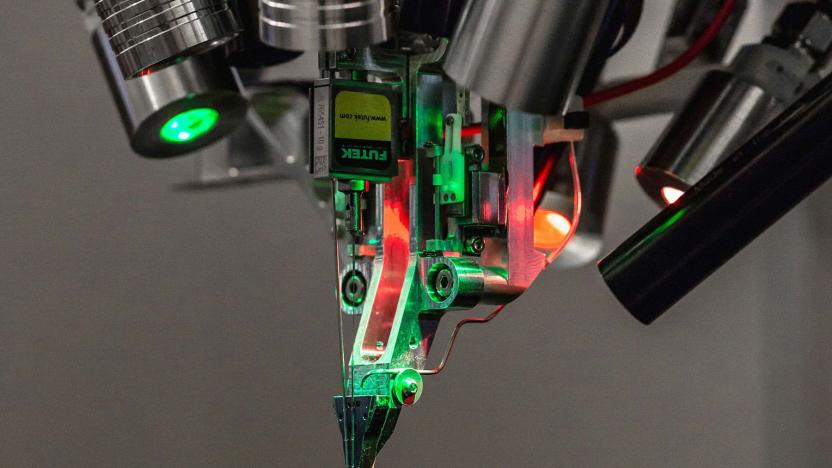brain-computer interface
Latest

Synchron's BCI implants may help paralyzed patients reconnect with the world
The burgeoning industry is already inundated with unrealistic expectations driven by overly-ambitious promises. BCI startup Synchron is trying a different tact.

Elon Musk’s Neuralink delays show-and-tell event to November 30th
On Sunday morning, Elon Musk tweeted that the showcase would take place on November 30th.

Synchron says it's the first to implant a human brain-computer interface in the US
Synchron says it's the first to implant a human brain-computer interface in the US, beating Elon Musk's company.

Many Americans distrust emerging technology, new study finds
Change is hard and new things are scary, according to the survey's respondents.

Snap buys a brain-computer interface startup to power future AR glasses
Snap has bought the brain-computer interface startup NextMind to power future Spectacles AR glasses.

FDA clears Synchron's brain-computer interface device for human trials
A clinical trial will get under way in New York later this year.

Neuralink's brain-computer interface demo shows a monkey playing Pong
Elon Musk's Neuralink is building brain-computer interfaces, like the one that allows this monkey to control a game of Pong with its thoughts.

NextMind's brain-computer interface is ready for developers
Beyond size and aesthetics, NextMind’s technology also seems fairly mature. Mostly because we’ll need to wait for a library of apps to be built for it first, but also it’s still a new technology -- and it takes some practice to become “fluent” with it, as my terrible performance on a mind-controlled game of Breakout can attest. Right now, the applications are pretty simple: Mostly controlling media and games and so on, but NextMind’s founder and CEO, Sid Kouider is confident the technology will evolve to the point where you can simply think of an image to search for it, for example.

Elon Musk teases 'working Neuralink device' reveal on August 28th
Elon Musk has revealed more details about a promised development update for Neuralink, the brain-computer interface designed to help folks with severe brain injuries.

Elon Musk's Neuralink hopes to put sensors in human brains next year
While we waited for Neuralink to present the progress it's made over the last couple of years in brain-computer interface technology, the New York Times and Bloomberg published information from an early briefing and it's stuff that's straight out of science fiction. The Elon Musk-backed company claims its "sewing machine-like" robot will be able to implant threads deep into a human brain.

For the first time, a paraplegic has walked without a robotic suit
A paraplegic has walked without robotics using his own brain waves, thanks to research done at Southern California's UC Irvine. Scientists used a computer to "link" 28-year-old Adam Fritz's brain to his legs over a Bluetooth connection, bypassing the severed region of his spinal cord. An EEG then picked up signals from his brain, which were relayed by a "brain-control interface" (BCI) computer to electrodes on his knee, triggering walking movements. Though Fritz was supported and only walked haltingly for 12 feet, the research is being heralded as a milestone -- so far, paralyzed patients have only be able to walk using suits like that from Ekso Bionics.

University of Minnesota researchers flex the mind's muscle, steer CG choppers
You've undoubtedly been told countless times by cheerleading elders that anything's possible if you put your mind to it. Turns out, those sagacious folks were spot on, although we're pretty sure this pioneering research isn't what they'd intended. A trio of biomedical engineers at the University of Minnesota have taken the realm of brain-computer interfaces a huge leap forward with a non-invasive control system -- so, no messy drills boring into skulls here. The group's innovative BCI meshes man's mental might with silicon whizzery to read and interpret sensorimotor rhythms (brain waves associated with motor control) via an electroencephalography measuring cap. By mapping these SMRs to a virtual helicopter's forward-backward and left to right movements, subjects were able to achieve "fast, accurate and continuous" three-dimensional control of the CG aircraft. The so scifi-it-borders-on-psychic tech could one day help amputees control synthetic limbs, or less nobly, helps us mentally manipulate 3D avatars. So, the future of gaming and locomotion looks to be secure, but we all know where this should really be headed -- defense tactics for the Robot Apocalypse.

G-Tec Intendix brain-computer interface ready for consumers (video)
If you've seen G-Tec's thought control cap being used to control a Second Life avatar, play a game of Pong, or make music in an orchestral setting, you probably wondered when the thing would become available for less frivolous pursuits (to help the disabled communicate, for starters). Well, it looks like that day is close at hand: With the brand name Intendix, the €9000 (about $12,250) brain-computer interface gives you everything you need to send text messages with brain activity alone via EEG cap. According to the company, most people achieve five to ten characters per minute the first time they use the thing, with some folks eventually typing as fast as 1 character per second. In addition to text messages, the system can also be used to trigger an alarm, send email, or send commands to external devices. There's no word on a shipping date yet, but we did thoughtfully provide that Second Life demo for you after the break.

Thought controlled orchestra makes its debut in Prague
The Multimodal Brain Orchestra had its world premiere last week in Prague, a city known for its big thinkers (and its Velvet Revolution). As a guy in black tie-and-tails led the traditional players through their arpeggios and glissandos, an "emotional conductor" led four performers fitted with G-Tec caps as they controlled both visuals and the sounds, frequencies, and volumes of various instruments. The controls were based on two of the effects that EEGs measure, SSVEP (or steady-state evoked potential) and the P300 signal. While we're not sure if this will ever take off in the classical world, we do think that there are quite a few turntablists who could do some wild things with a thought controlled Kaoss Pad. Are you listening, Korg? Video after the break.[Via Make]

Mind reading gets closer to real thanks to Canadian scientists
Hate to break it to you, but that clairvoyant you've been paying daily to read you fortune cookies while blindfolded actually isn't some sort of medium. Tough to swallow, we know. That said, researchers at Canada's largest children's rehabilitation hospital are getting closer to equipping entrepreneurial individuals with the tools they need to read minds. By measuring the intensity of near-infrared light absorbed in brain tissue, scientists were able to decode a person's preference for one of two drinks with 80 percent accuracy, all without a single minute of training on the human's behalf. This research gives promise to finding out true feelings of those who can't speak or move due to physical limitations, though there's no word on how close it is to becoming viable outside of a lab. As an aside, we hear Professor X is pretty perturbed.

USF scientists develop brainwave controlled wheel chair
Those crazy kids at the University of South Florida are at it again -- they've given us 'intelligent' scarecrows and engaged an RFID network in the fight against Alzheimer's, and now they're doing some rather interesting work with the Brain-Computer Interface (BCI). The device uses an electrode-covered head cap to capture P-300 brainwave responses and convert them into action, such as "typing" or manipulating a robotic finger. The team has developed a motorized "smart wheelchair" that allows users to pilot the chair and even control a robotic arm without any physical movement whatsoever. USF researchers say that this will be a great help not only for those with special needs, but also for the extremely lazy.[Via MedGadget]

OCZ's Neural Impulse Actuator gets reviewed, mice everywhere safe for now
We tried to take OCZ's Neural Impulse Actuator seriously, we really did. But unable to suppress those recurring images of Geordi La Forge, we simply couldn't help ourselves from having a laugh at this thing's expense. Nevertheless, the way-more-solemn dudes and dudettes over at HotHardware managed to give this brain-computer interface a fair shake, and overall, it was pretty impressed. Still, the bottom line is this: "the NIA is a very unique input device and possibly the first true brain-computer interface to hit the retail market," but it's not "a replacement for traditional input methods." Granted, critics did point out that it would supplement current devices quite well, but only after "slogging through" hours upon hours of training. The hardcore among us may be willing to put in the time necessary to really get a lot out of this; for everyone else, just continue to point and laugh while masking your ignorance.

Researchers devise neural implant that learns over time
Brain-machine interfaces have done quite a bit in helping handicapped individuals interact with prosthetic limbs, computers and other humans, but a new neural implant concocted at the University of Florida could make all those past devices look archaic. Put simply, researchers have discovered a method that would enable brain-machine interfaces to "adapt to a person's behavior over time and use the knowledge to help complete a task more efficiently." Until now, the brain was the instrument doing all the talking while the computer simply accepted commands; with this method, "the computer could have a say in that conversation, too." In all seriousness, this type of learning mechanism could be game-changing in the world of physical therapy, but we hesitate to give something mechanical inside of our body too much free will, ya dig?[Via Physorg]

German scientists develop nerdiest brain-computer interface yet
Brain-computer interfaces have been popping up left and right lately, but the latest system from Germany's Technical University of Braunschweig, might be the silliest one we've seen so far. While the system doesn't involve the careful placement of electrodes, it does require you to don a large metal helmet fitted with sensors, which can even detect brain activity through hair -- and makes you look like Magneto on a bad day. The system is solid enough to allow test subjects to control an RC car and researchers say the tech is similarly applicable to wheelchairs and prosthetics. Yeah, that's great -- we'll stick with the dangerous neurosurgery implantation over this contraption, guys. Video after the break.

Researchers develop robotic brain-computer interface
Brain-computer interfaces have been kicking around for a few years now, but they're relatively slow and unwieldy, which kind of puts a damper on world-domination plans -- the guy with the keyboard would probably be well into the missile-launch sequence by the time you've strapped on your dork-helmet. That might be slowly changing, though, as Caltech researchers are working on a robotic brain-computer interface, which can currently be implanted directly into non-human primate brains and move itself around to optimize readings. Although the MEMS-based motor system that actually moves the electrodes is still being developed, the software to do the job is ready to go, and the whole system being presented this week at the IEEE International Conference on Robotics and Automation in Pasadena. Robot-android chimps? Sure, that's just what we need.








